Physical Address
304 North Cardinal St.
Dorchester Center, MA 02124
Abdominal ultrasound can be used to obtain images of the hepatobiliary, urogenital, and pelvic structures. The approach to the urogenital system, point-of-care pelvic ultrasound, focused assessment with sonography for trauma, and other subjects are discussed in Chapter 42, Chapter 43, Chapter 44, Chapter 45, Chapter 46 . In this chapter, examination of various abdominal targets such as the hepatobiliary system, spleen, pancreas, gastrointestinal (GI) tract, and peritoneum is featured as part of the holistic approach (HOLA) ultrasound protocol that was introduced in Chapter 1 .
In the intensive care unit (ICU), patients’ body habitus, the region of interest (ROI) in question, the presence of bowel gas, and acoustic windows influence the scanning approaches and types of transducer used. Moreover, physiologic stability affects the decision to pursue more robust imaging technologies such as computed tomography (CT) versus ultrasonography.
Standard ultrasound examination is performed with curvilinear transducers (3.5 to 5 MHz), but phased-array or microconvex transducers can be of assistance. High-frequency transducers may be used to visualize the GI tract. It is helpful to apply HOLA scanning ( Chapter 1 ) techniques ( Figure 41-1 ). A detailed description of the technique suggested for abdominal scanning is illustrated in Figures 41 E-1 to 41 E-6 . In brief, by sweeping the transducer from the epigastrium to the right posterior axillary line along a mainly sagittal approach, various structures are examined consecutively: the pancreas and left liver lobe anterior to the inferior vena cava (IVC), the right liver lobe (right hypochondrium), and the main portal triad (main portal vein [PV], common bile duct [CBD], and hepatic artery [HA]; the PV is posterior). The gallbladder (GB), liver, right kidney, and Morison pouch are also visualized. Oblique subcostal views allow visualization of both hepatic lobes and the hepatic veins (right, middle, left) converging toward the IVC. Intercostal, subcostal, and flank views complete the survey of the hepatobiliary system, pancreas, and spleen. The spleen is best visualized via a left posterolateral intercostal approach. Midabdominal and alternative (flank) views are used to visualize major vascular structures. The small intestine can be examined systematically in parallel overlapping lanes, although a cross-sectional examination of the colon is usually performed to identify its major segments. Bowel loops are best visualized if intraperitoneal fluid is present (see Figures 41 E-1 to 41 E-6 ).
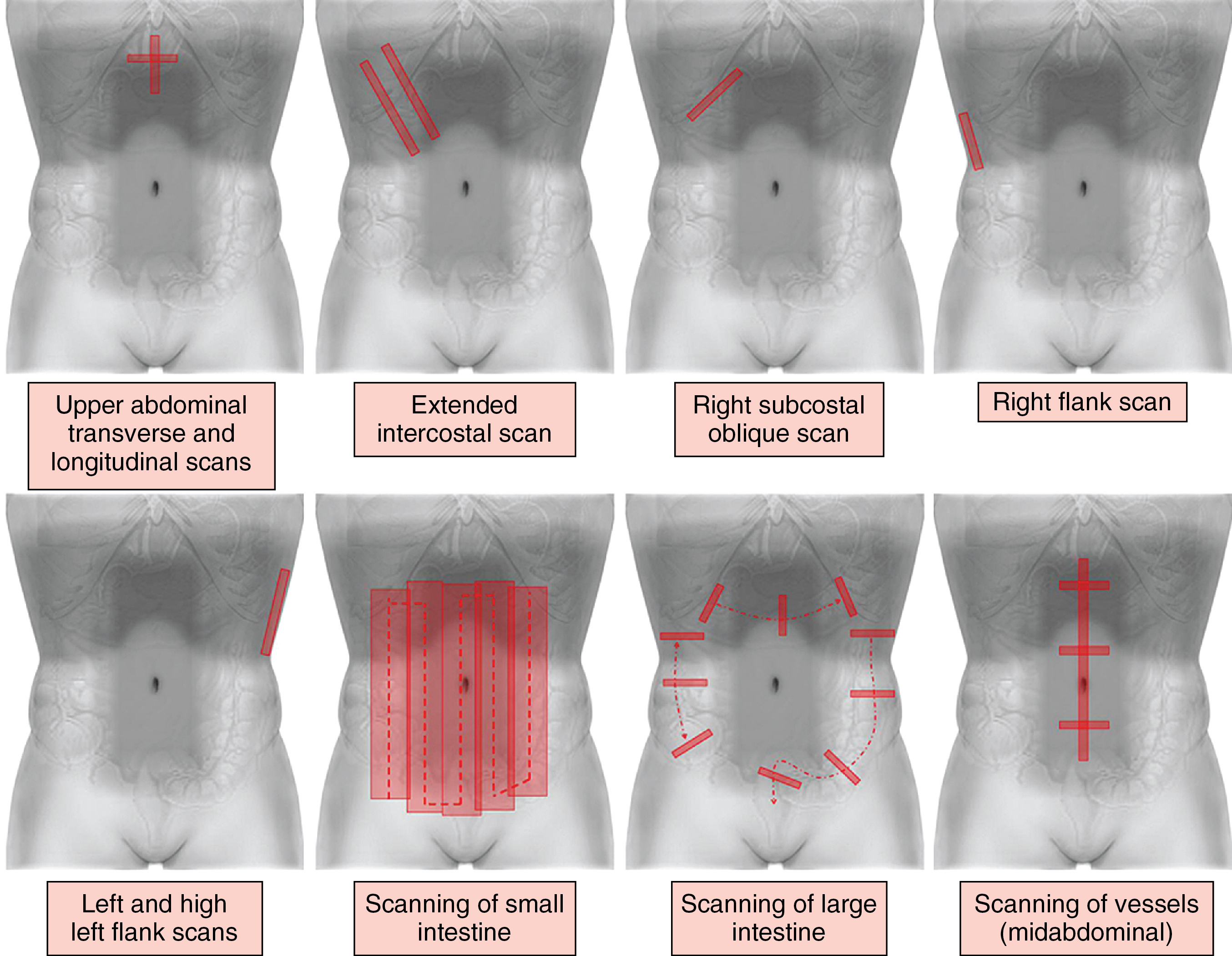
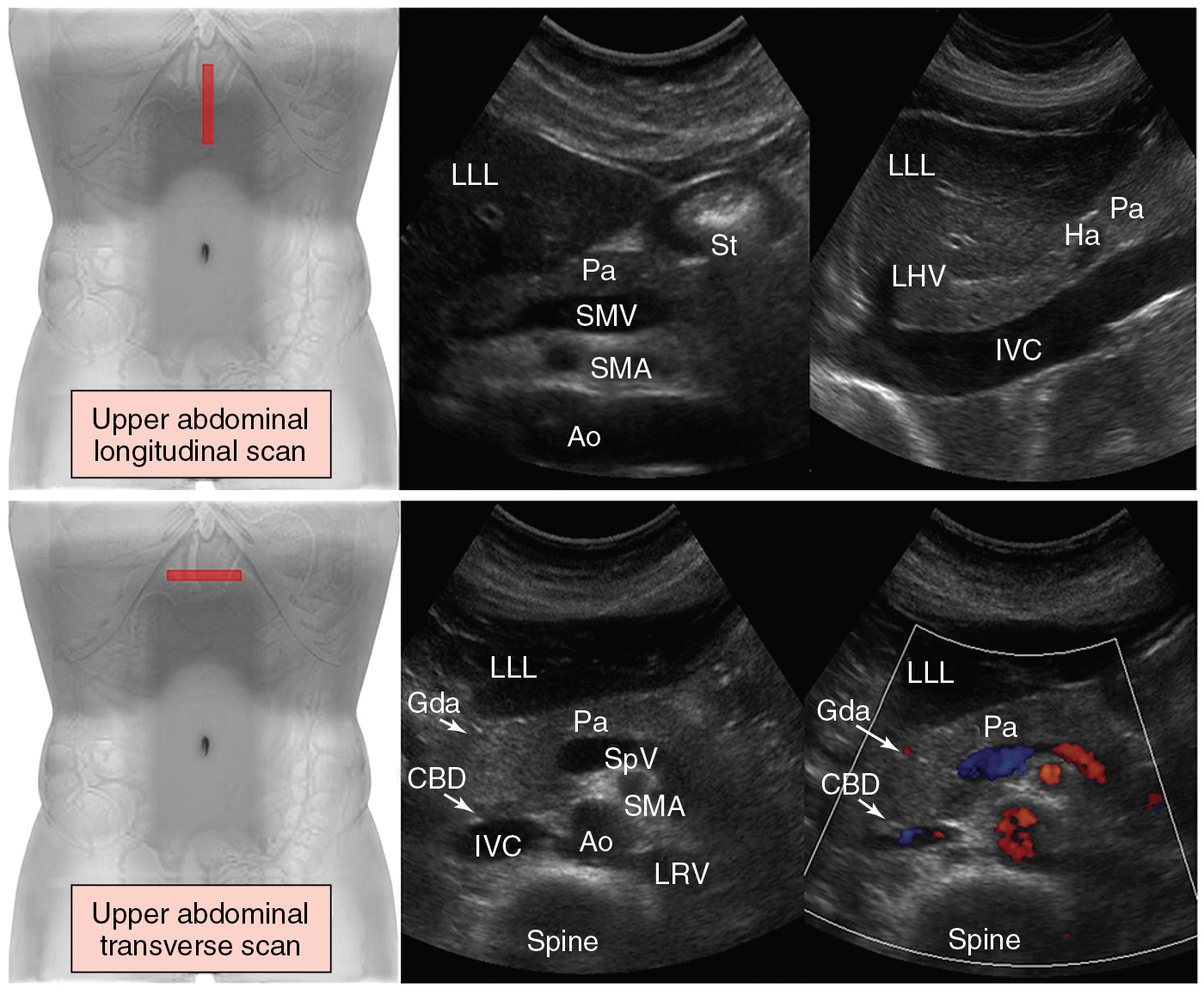
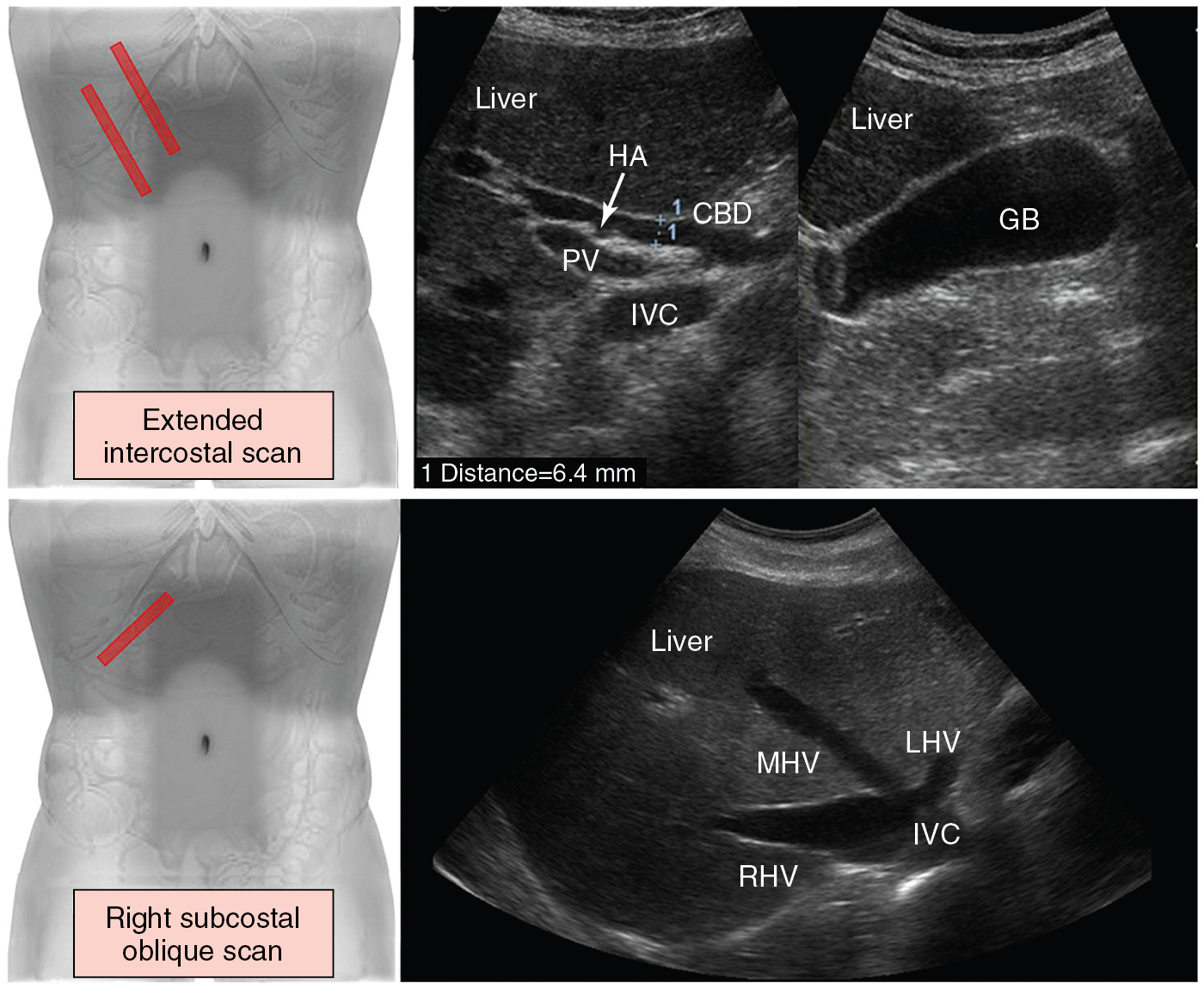
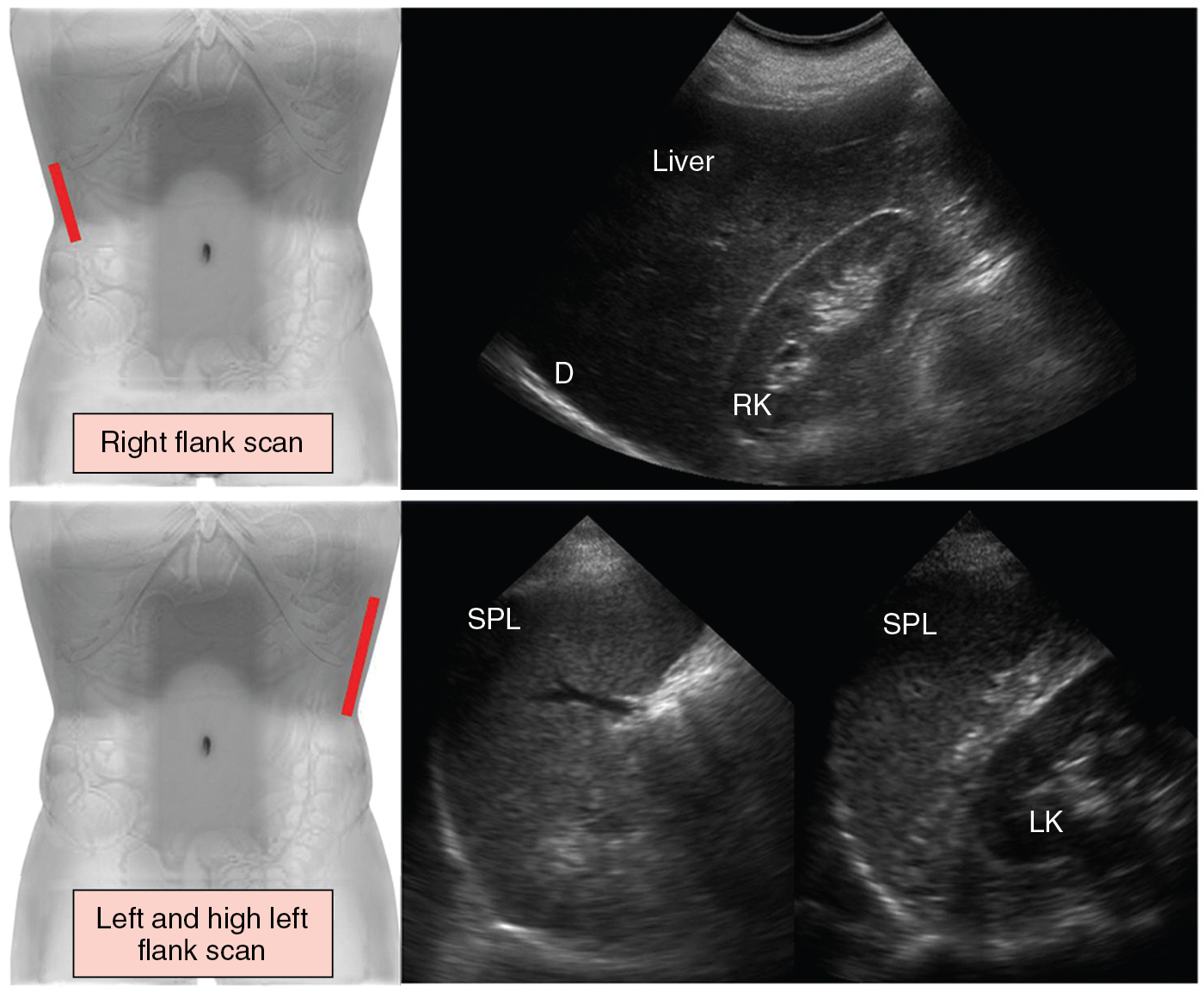
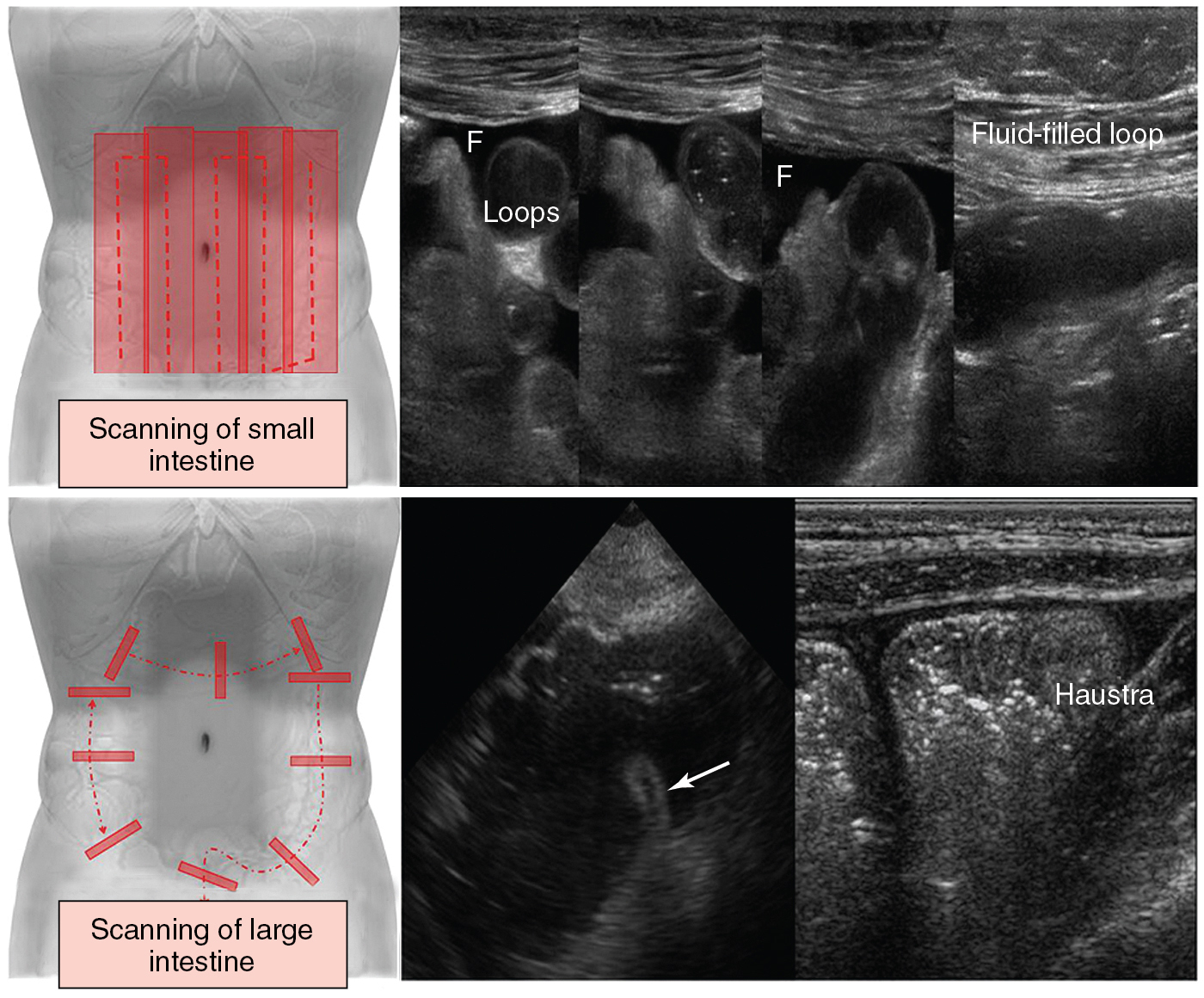
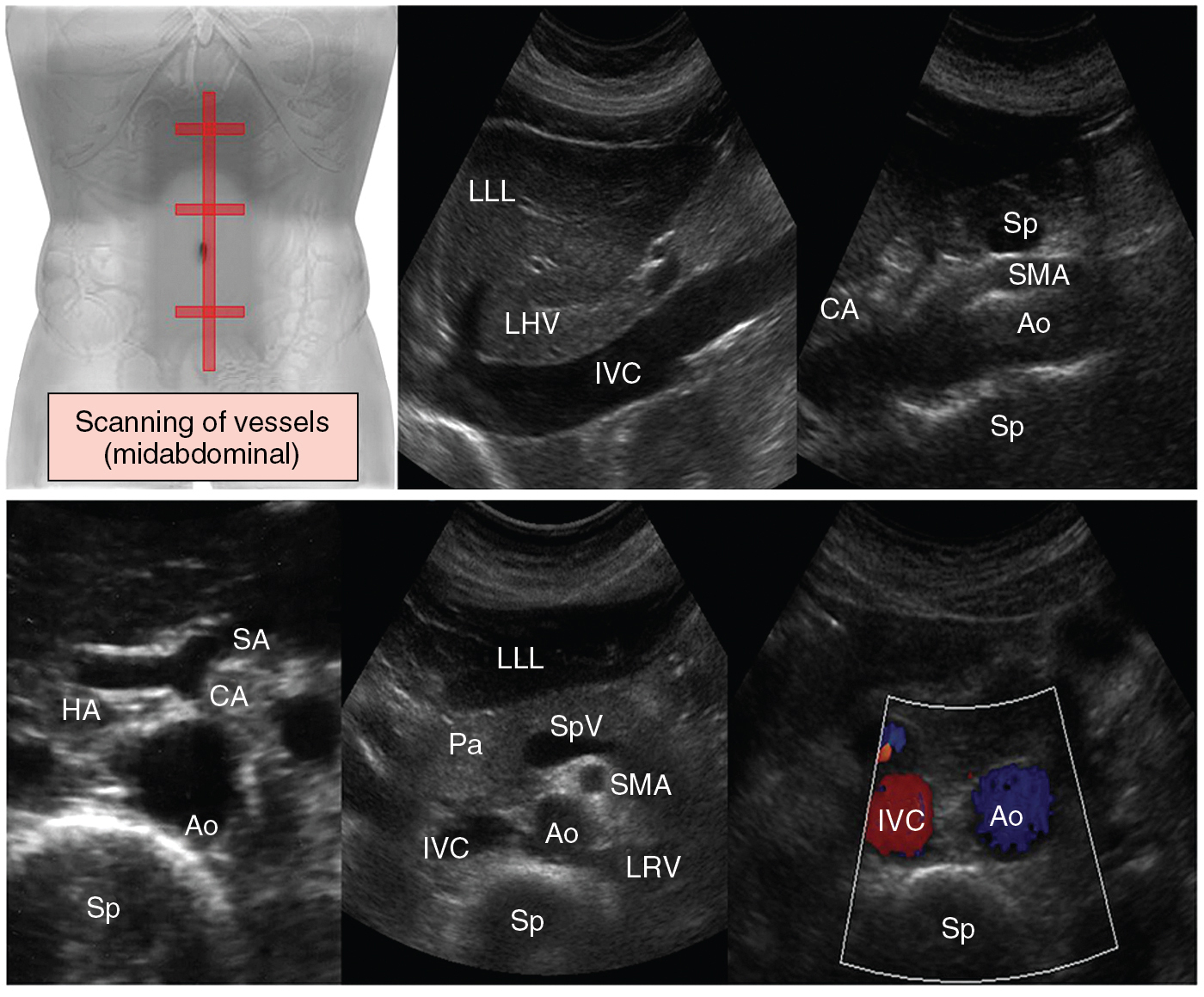
![Figure 41 E-6, Alternative (flank) scanning of abdominal vessels. If midabdominal scanning is not feasible (e.g., trauma, aerocolia, surgery), major abdominal vessels can be depicted by alternative right flank views in supine patients in the intensive care unit. This view requires various adjustments of the transducer (rotating and tilting) and the scanning plane, which depends on positioning of the patient, to visualize major abdominal vessels such as the inferior vena cava (IVC) and the aorta (Ao) ( the right alternative flank [RAF] view is suggested by Dr. Karakitsos; however, further analysis is beyond the scope of this chapter). Figure 41 E-6, Alternative (flank) scanning of abdominal vessels. If midabdominal scanning is not feasible (e.g., trauma, aerocolia, surgery), major abdominal vessels can be depicted by alternative right flank views in supine patients in the intensive care unit. This view requires various adjustments of the transducer (rotating and tilting) and the scanning plane, which depends on positioning of the patient, to visualize major abdominal vessels such as the inferior vena cava (IVC) and the aorta (Ao) ( the right alternative flank [RAF] view is suggested by Dr. Karakitsos; however, further analysis is beyond the scope of this chapter).](https://storage.googleapis.com/dl.dentistrykey.com/clinical/VarioustargetsintheabdomenhepatobiliarysystemspleenpancreasgastrointestinaltractandperitoneumCONSULTANTLEVELEXAMINATION/6_3s20B9781455753574000503.jpg)
The use of ultrasound to assess liver size is not particularly accurate; however, the maximal diameter of the right lobe (midaxillary line) should be less than 16 cm. Liver parenchyma should be homogeneous and isoechoic or slightly hyperechoic in comparison to the renal cortex. The GB is pear shaped with its longitudinal and transverse diameters normally measuring less than 10 and greater than 5 cm, respectively. It displays cystic features, including a smooth margin wall, anechoic interior, and distal acoustic enhancement. The anterior wall of the GB, best evaluated between its lumen and the liver parenchyma, should be less than 3 mm. The maximal normal diameter of the CBD is approximately 7 mm (up to 10 mm in the elderly or 12 mm after cholecystectomy). Intrahepatic bile ducts are identified occasionally, especially in the elderly, as anechoic thin cylindric tubes running anterior and parallel to branches of the PV. A guide for imaging the pancreas is to detect the splenic vein posterior to the pancreas. A fluid-filled stomach can be used as an acoustic window. The pancreas normally has a homogeneous appearance and is isoechoic or slightly hyperechoic relative to the liver. The spleen is a wedged-shaped organ with a craniocaudal diameter smaller than 12 cm and a thickness of less than 5 cm (midaxillary line) and is usually oriented parallel to the left 10th rib.
For imaging of the GI tract, graded compression is applied to displace interfering bowel loops with gas and feces, decrease the distance from the ROI, and assess the rigidity of the underlying structures. The stomach is scanned in longitudinal and transverse sections (subxiphoid approach), whereas a lateral transsplenic view best depicts the fundus. The distal part of the esophagus is visualized in the epigastrium by tilting the transducer cranially and using the left liver lobe as an acoustic window. Visualization of the gastric tube is a useful guide. The duodenum surrounds the head of the pancreas, and its third part may be visible between the superior mesenteric artery and aorta. The small intestine cannot be evaluated over its entire length but is scanned in a general sweep by making vertical, parallel, and overlapping lanes. After identification of the cecum , the colon is usually scanned in transverse sections by carefully following along the ascending, transverse, and descending segments to the distal sigmoid into the pelvis. Finally, the rectum can be visualized through a distended urinary bladder. Normal bowel wall consists of five concentric layers (distal to the esophagus), and its thickness is practically unchanged from the stomach to the colon (2 to 4 mm). Distinguishing features of the small intestine include intense peristalsis and valvulae conniventes (mucosal folds are best visible with a fluid-filled lumen). Key features of the large intestine include a fixed position and haustra , which give the colon, especially the ascending and transverse parts, a segmented-like appearance. The “3, 6, 9 rule” refers to the maximal normal intestinal diameter (small intestine ≤3 cm, colon ≤6 cm, cecum ≤9 cm) and aids in identifying intestinal dilatation and distinguishing the small from the large intestine. Doppler provides information on the main mesenteric vessels and GI tract vascularity in general.
Become a Clinical Tree membership for Full access and enjoy Unlimited articles
If you are a member. Log in here